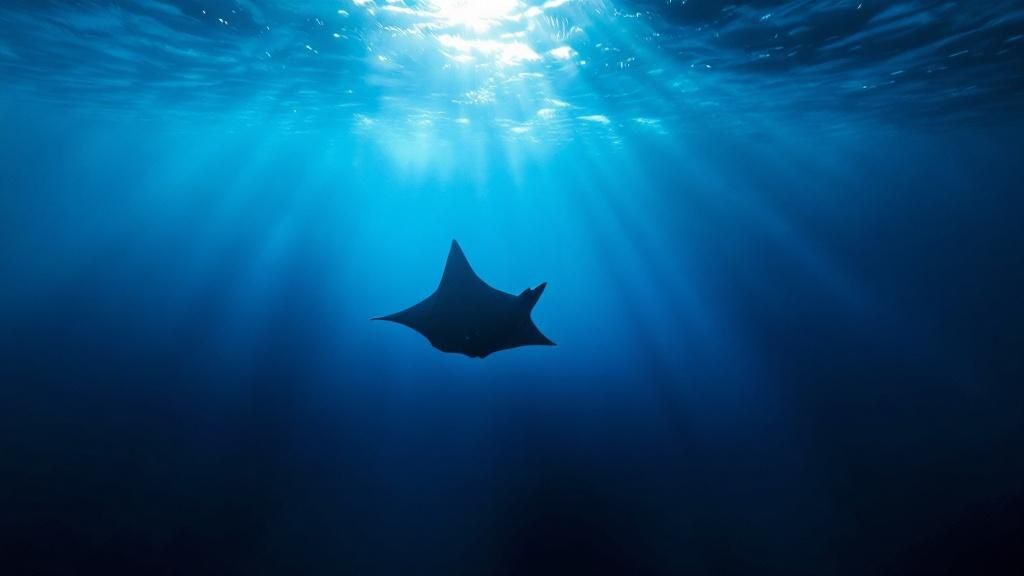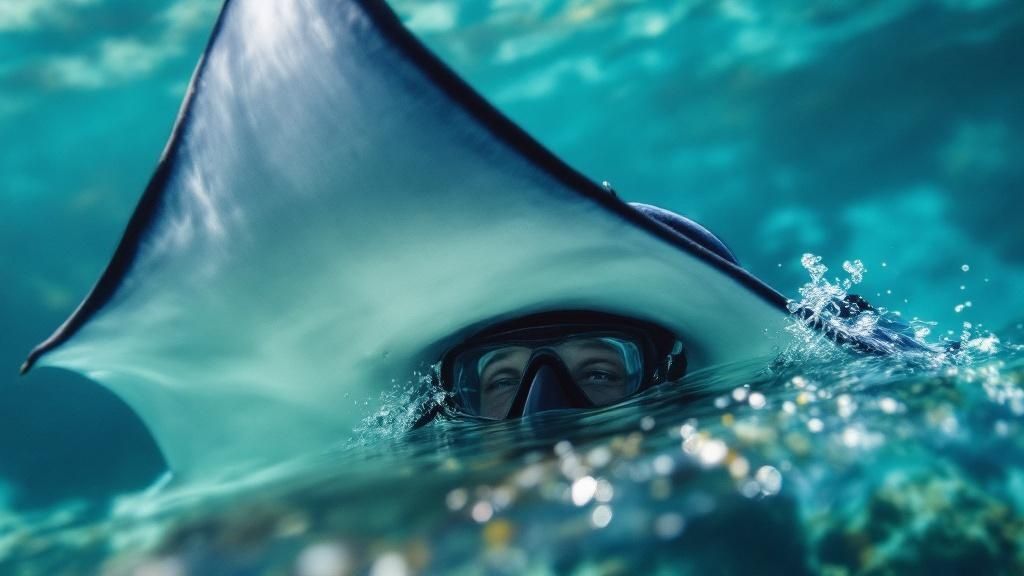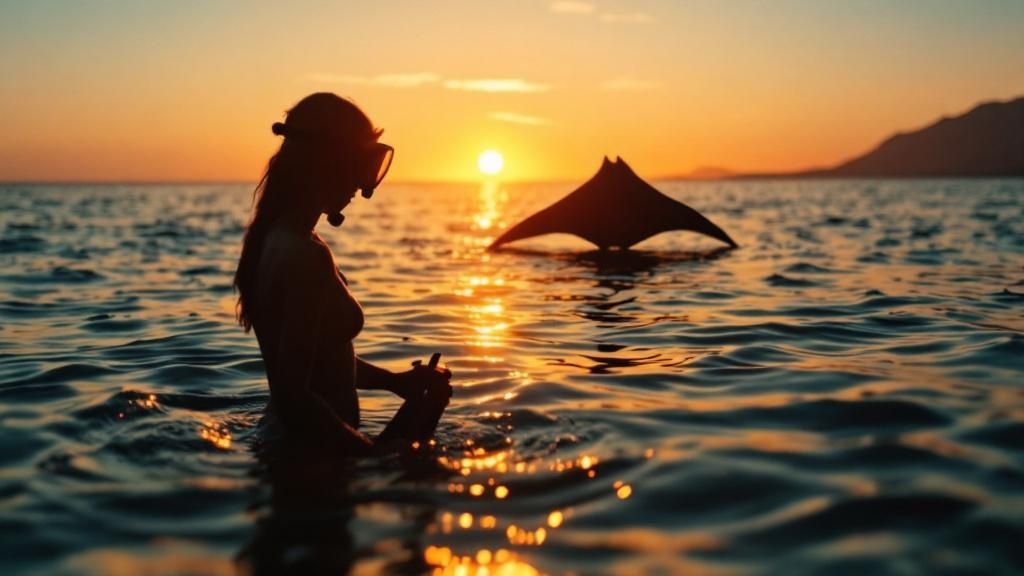Manta Ray Snorkel Big Island: The Ultimate Night Experience
- Byron
- Jul 26
- 11 min read
Picture this: you're floating in the warm, dark waters off the Kona coast. Below you, magnificent manta rays with wingspans wider than a car glide effortlessly through the water. This is the world-famous manta ray snorkel Big Island experience, and it's truly one of Hawaii's most magical and unforgettable moments. It’s like witnessing a silent, graceful ballet performed by gentle giants in their own open-ocean theater.
As you can see from the reviews for Manta Ray Night Snorkel Hawaii, this tour is consistently a highlight for visitors.
Your Unforgettable Night with Gentle Giants
Think of this as your personal guide to one of the planet's top wildlife adventures. We'll cover everything you need to know, from why the Big Island is the place for this encounter, to picking the perfect tour and how to interact safely with these incredible animals. Making sure you go with a reputable, local company is key to having a great and responsible trip.

This is so much more than just another snorkeling trip. It’s a chance to feel a profound connection with the ocean and its inhabitants. You simply become a quiet observer, watching a stunning nighttime spectacle that has captivated visitors and researchers here for decades.
What to Expect on Your Adventure
Your adventure starts by boat, heading out to a specific manta viewing spot just off the Kona coast as the sun dips below the horizon. The crew will give you a rundown on the mantas and, most importantly, the safety rules for being in the water with them.
Once it's time, you'll slip into the water and hold onto a specially designed light board that floats on the surface.
The genius of the light board is simple: the bright lights attract swarms of plankton, which happens to be the manta rays' favorite meal. This creates an illuminated, all-you-can-eat buffet that brings the mantas right up to your viewing area.
The best part? This experience is for almost everyone, including families and total beginners. You don't need to be an expert swimmer, just someone with a sense of adventure who wants to see something truly special. To really get a feel for what makes this a once-in-a-lifetime trip, you can dive deeper into the Manta Ray Snorkel Big Island experience.
Get ready to make some incredible memories as these gentle giants perform their mesmerizing underwater dance.
Of all the places in the world, why is the Kona coast the spot for a manta ray snorkel Big Island experience? It’s no accident. A unique blend of geography, biology, and a little human ingenuity creates a spectacle you can count on almost every single night.
It all started with a simple, almost accidental, discovery. Tour operators, like the experienced crew at Manta Ray Night Snorkel Hawaii, found that shining powerful lights into the water after sunset had an incredible effect.
The bright beams attract swarms of tiny phytoplankton, microscopic marine plants that are the foundation of the ocean's food web. This dense cloud of plankton essentially creates an all-you-can-eat buffet right at the surface. For the local manta rays, it's like seeing a giant neon sign flashing "Dinner is served!"
The World-Famous Manta Gathering Spots
This nightly "campfire" effect is so reliable that two specific locations along the Kona coast have become globally recognized manta hotspots.
Manta Village: This is the classic, original site just south of Kailua-Kona in Keauhou Bay. It’s where it all began, earning its name from decades of consistent manta ray visits.
Manta Heaven: Located a bit north of Kona, closer to the airport, this spot is just as dependable. It's a go-to for many tour operators, offering incredible, up-close encounters.
And this isn't just wishful thinking. The consistency of these sites is backed by years of hard data.
The nightly plankton buffet is so dependable that your chances of seeing mantas are greater than 90% on any given tour. That's a success rate you won't find anywhere else on Earth.
This incredible reliability has turned Kona into a living laboratory. Between 2009 and 2014, researchers and videographers were in the water six or seven nights a week, documenting the rays at Manta Village and Manta Heaven.
Their amazing work helped identify a resident population of around 130 individual rays, each with unique spot patterns. You can dive deeper into the numbers with these fascinating manta ray sighting statistics.
So, when you combine Kona's calm coastal waters with this brilliant feeding strategy and a healthy, resident manta population, you get the undisputed best place in the world to swim with these gentle giants.
Choosing Your Perfect Manta Ray Tour
Picking the right company for your manta ray snorkel Big Island tour is your first big decision, and it really sets the stage for the whole evening. Honestly, the biggest factor comes down to a simple choice: a small boat or a large one. Each offers a completely different vibe.

Small Boat vs. Large Boat Tours
Are you looking for a thrilling, up-close adventure or a more stable, spacious ride? That’s the core question.
Small boats, like agile zodiacs or rafts, feel more like a private expedition. With guest counts usually between 6 and 20 people, you get a much more personal touch. It’s perfect if you’re an adventurous spirit or a photographer who wants fewer people in the water and a more intimate view of the action.
On the other hand, bigger vessels like catamarans are all about comfort and stability. They're a fantastic choice for families, especially with younger kids, or for anyone who’s a bit worried about getting seasick. You’ll have more room to move around, and amenities like onboard restrooms are common.
Here’s a quick breakdown to help you decide which tour style fits you best.
Comparing Manta Ray Tour Options
Feature | Small Boat Tours | Large Boat Tours |
|---|---|---|
Group Size | Intimate (6-20 guests) | Larger groups |
Experience | Adventurous, faster ride | Stable and spacious |
Best For | Photographers, thrill-seekers | Families, nervous swimmers |
Amenities | Typically fewer | Often includes restrooms |
Ultimately, there’s no wrong choice—it just depends on the kind of memory you want to create.
How the In-Water Experience Works
No matter which boat you choose, the way you experience the mantas in the water is brilliantly simple and safe. You don't need to be a champion swimmer or hold your breath for minutes on end. The setup is designed so that almost anyone can participate comfortably.
After a short boat ride, your crew will set up a large, custom-made flotation board in the water.
Think of it as a floating light raft. It’s equipped with powerful lights that shine down into the dark water, attracting plankton. The plankton, in turn, brings the hungry manta rays right up from the depths. You just hold onto the handles, float effortlessly on the surface, and watch the magic unfold directly below you.
This clever design keeps everyone safely at the surface, ensuring you don’t accidentally disturb the mantas while giving you a stable, front-row seat to the show.
Why Sustainable Practices Matter
It’s incredibly important to pick a tour operator that puts the manta rays' well-being first. The best companies are "Manta Ray Green List" certified and strictly follow guidelines created by local conservation experts to protect these gentle giants.
A responsible guide will make sure everyone understands the rules before getting in the water:
Look, Don’t Touch: Never, ever touch a manta ray. Touching them can damage the protective mucous layer on their skin.
Stay Flat: Float horizontally on the surface to create a smaller, less intimidating profile for the mantas.
No Diving Down: Resist the urge to dive down for a closer look. This can disrupt their natural feeding behavior.
Following these guidelines ensures that manta ray snorkel Big Island tours remain a sustainable and ethical adventure for years to come. If you're looking for more details on what to expect, check out our complete adventure guide for a manta ray snorkel on the Big Island.
Booking with a conscientious company like **Manta Ray Night Snorkel Hawaii** means your once-in-a-lifetime experience is also a respectful one.
Alright, let's get to know the incredible creatures you're here to see. When you slip into the water for your manta ray snorkel on the Big Island, you’re not just looking at fish—you're meeting intelligent, graceful animals that move like nothing else on Earth.
The Kona Coast is a special place, home to two different types of manta rays, which makes every trip out a little different.
Most nights, you'll be swimming with the Reef Manta Ray (Mobula alfredi). These are the local residents, and they are truly impressive, with wingspans that can stretch up to 12 feet. On rare, unforgettable nights, some snorkelers get to see the Giant Oceanic Manta (Mobula birostris). These guys are the real titans, sometimes measuring over 20 feet from wingtip to wingtip.
Don't Worry, They're Gentle Giants
Let's get one thing straight right away. Manta rays are huge, but they are completely harmless to people. It's a common mix-up, but they are nothing like their distant cousins, the stingrays.
No Stingers, No Teeth: Mantas have no barbs, stingers, or teeth. They're filter feeders, gently gulping down plankton.
Just Curious: They aren't aggressive at all. If they swim near you, it's out of simple curiosity. They're known for being incredibly smart and peaceful.
Think of them less like a shark and more like a massive, underwater butterfly. Their only defense is to swim away, which is why all the tour rules are about being still and letting them feel safe.
A Fingerprint on Their Belly
Here’s something that makes this experience even more personal. Every single manta ray has a unique pattern of black spots on its belly. It's their version of a human fingerprint, and no two are alike.
This is how local guides and researchers tell them apart. They use these spot patterns to name the rays, track their movements, and monitor the health of the population. It’s not just a tour; it's a long-term relationship with these animals.
Knowing this changes everything. You’re not just observing a species; you’re being introduced to individuals with names and histories. These mantas are a huge deal here. The snorkel tours bring in about 80,000 visitors a year, making them vital to the local ecotourism economy.
Culturally, the manta ray, or hāhālua (meaning ‘two breaths’), even appears in the ancient Hawaiian Kumulipo creation chant. You can learn more about the cultural importance and biology of Hawaii's mantas to see just how deep the connection runs.
When you go on a tour, you’re becoming part of this story. You're meeting a local celebrity and helping to support a community that works hard to protect them. Choosing a great operator like **Manta Ray Night Snorkel Hawaii** means you'll have an incredible time while also doing it the right, respectful way.
How to Prepare for Your Night Snorkel
A little bit of prep work can be the difference between a good trip and an absolutely incredible one. Think of this as your pre-flight checklist for your manta ray snorkel Big Island adventure—it’ll help you feel relaxed, confident, and ready for an unforgettable night. While your tour company will handle the main gear, bringing a few personal items will make your experience that much better.
Any good tour operator, like our team at Manta Ray Night Snorkel Hawaii, has you covered with all the essential equipment. You don't need to worry about packing your own bulky gear.
They’ll provide:
Wetsuit tops to keep you surprisingly warm in the cool night water.
Snorkels, masks, and fins that are properly sanitized and fitted.
Flotation devices, which are usually large, stable light boards that you simply hold onto.
This means all you have to do is show up ready for the magic.

What You Should Bring
Your focus should be on comfort, both before you hit the water and after you get out. The easiest thing to do is arrive wearing your swimsuit under your regular clothes. That way, you’re ready to go in minutes.
For after your swim, you’ll be glad you packed:
A dry, fluffy towel.
A warm change of clothes or at least a hoodie or windbreaker for the boat ride back to the harbor.
Any personal medications you might need (like an inhaler or an EpiPen).
A Quick Tip on Motion Sickness: If you even think you might get seasick, take your preferred remedy well before you leave the dock. While the boat ride is usually quite smooth, it's always better to be prepared so nothing gets in the way of you enjoying the main event.
The Typical Tour Timeline
Knowing what to expect can help you relax and just enjoy the experience. Most tours run on a pretty standard schedule. You'll check in at the harbor, get a quick but thorough safety briefing, and then take a beautiful boat ride out to the manta site, often timed perfectly with the sunset.
Once you’re there, you'll spend about 30-45 minutes in the water, floating effortlessly while the gentle giants dance below you. After the snorkel, it’s back on the boat for a warm, cozy ride to shore, where you'll be buzzing from the incredible encounter you just had.
When you slip into the water for a manta ray snorkel on the Big Island, you're entering their world. It’s a genuine partnership, and protecting these gentle giants is everyone's number one job. To make sure the experience is incredible for you and safe for the mantas, there are a few key guidelines to follow. It all boils down to one golden rule that you absolutely must remember.
The Golden Rule: Do Not Touch
Above all else, never, ever touch a manta ray. It's the most important rule of the entire experience. Their skin has a delicate, protective slime coat that acts as a shield. Touching them, even accidentally, can rub this layer off, leaving them wide open to dangerous bacteria and skin infections.
Any good guide, like the ones from our team at Manta Ray Night Snorkel Hawaii, will hammer this point home before you even get your fins wet. Your role is simply to be a respectful guest in their underwater home.
Think of yourself as a log floating peacefully on the surface. Your only job is to stay calm, keep your body horizontal, and hang onto the light board. The mantas will do the rest, putting on an incredible show right beneath you.
Why These Rules Are So Important
These rules aren't just polite suggestions—they are critical for protecting the local manta ray population. Recent genetic studies have shown just how special and fragile this group of animals is. The manta rays off the Kona coast are a small, isolated community of just a few hundred individuals.
According to a NOAA Fisheries genetic study on Hawaiian manta rays, they don't really mix with mantas from other islands. This genetic isolation makes them extremely vulnerable; what affects one could impact the entire group for years to come.
By simply following these rules, you become an active part of the conservation effort. You're helping ensure these magnificent creatures can continue to grace our waters and amaze visitors for generations. To learn more about having a responsible and breathtaking tour, take a look at our ultimate guide for unforgettable encounters with manta rays.
Answering Your Questions About the Manta Ray Snorkel
It’s completely normal to have a few questions buzzing around your head before you commit to a tour, no matter how exciting it sounds. Let's tackle some of the most common ones we hear so you can feel totally confident and ready for your manta ray snorkel Big Island adventure.

After helping thousands of snorkelers have the time of their lives, we've gotten pretty good at anticipating what's on your mind. Here are the straight-up answers to a few common queries.
Is This Snorkel Safe for Beginners and Kids?
Yes, absolutely! This experience is designed to be incredibly accessible, even if you’ve never put on a snorkel mask before. You're not swimming around freely; instead, you'll be holding onto a large, custom-made light board that floats on the surface.
Think of it as your personal, stable viewing platform. Flotation devices are provided, and expert guides are always in the water with you, keeping a close eye on everyone. Just make sure to double-check the minimum age requirements with the specific tour operator when you book.
Is It a Guarantee I’ll See Manta Rays?
Because manta rays are wild animals in their natural ocean home, no one can promise a sighting with 100% certainty. That said, the success rate on the Kona coast is remarkably high—we're talking over 90% on most nights!
Many of the best tour companies, ours included, offer a "manta guarantee." It’s our way of showing confidence in the experience. If the mantas decide not to show up on your night, you can usually come back again for free on another trip (just be aware it's subject to availability).
What If I Get Cold in the Water?
This is a really common concern, and a valid one—it is a night snorkel, after all. While Kona’s ocean temperatures are pretty comfortable year-round, you can definitely feel a chill after a while.
That’s why tour operators provide wetsuit tops. We strongly recommend you wear one! It makes a world of difference and allows you to focus completely on the incredible ballet happening below you, not on being cold. Once you have these details sorted, you’ll be ready to pick from the best manta ray snorkel Big Island tours and have an unforgettable experience.
Comments